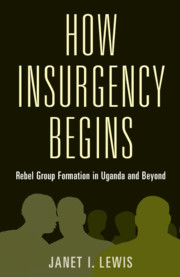Book contents
- How Insurgency Begins
- Cambridge Studies in Comparative Politics
- How Insurgency Begins
- Copyright page
- Contents
- Figures
- Tables
- Acknowledgments
- Part I Rethinking How Armed Conflicts Begin
- 1 Introduction
- 2 A Theory of Rebel Group Formation
- Part II Uganda and Beyond
- Part III Implications
- Book part
- References
- Index
- Series page
1 - Introduction
from Part I - Rethinking How Armed Conflicts Begin
Published online by Cambridge University Press: 18 September 2020
- How Insurgency Begins
- Cambridge Studies in Comparative Politics
- How Insurgency Begins
- Copyright page
- Contents
- Figures
- Tables
- Acknowledgments
- Part I Rethinking How Armed Conflicts Begin
- 1 Introduction
- 2 A Theory of Rebel Group Formation
- Part II Uganda and Beyond
- Part III Implications
- Book part
- References
- Index
- Series page
Summary
This chapter introduces the puzzles at the core of the book: How does rebel group formation initially start, and why do many rebellions fail before becoming viable challengers to a government? Few prior studies have systematically answered this question because rebel groups typically form in remote areas of weak states and are clandestine. These features of nascent rebellion have thus limited knowledge about conflict onset; most recent conflict onset studies rely on datasets that do not capture the start of violence. This chapter presents the book’s core argument; describes its contributions to literatures on conflict, ethnicity, and state building; describes its methodological approach of retracing all incipient rebellions in Uganda since 1986, and probes the relevance of findings from Uganda in other Eastern and Central African states.
Keywords
- Type
- Chapter
- Information
- How Insurgency BeginsRebel Group Formation in Uganda and Beyond, pp. 3 - 27Publisher: Cambridge University PressPrint publication year: 2020

